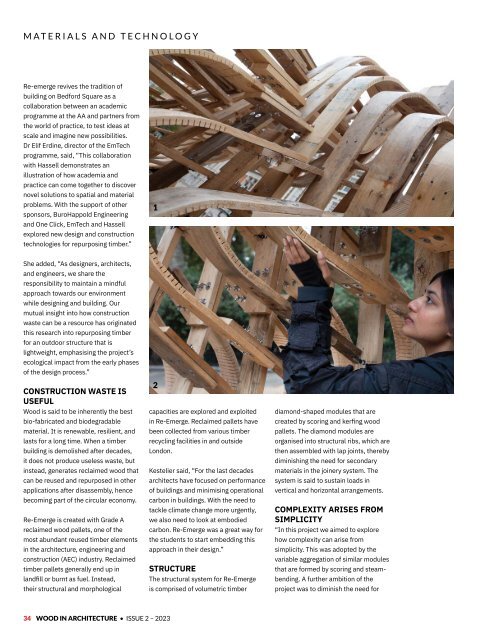WIA_ISSUE2_2023
You also want an ePaper? Increase the reach of your titles
YUMPU automatically turns print PDFs into web optimized ePapers that Google loves.
MATERIALS AND TECHNOLOGY<br />
Re-emerge revives the tradition of<br />
building on Bedford Square as a<br />
collaboration between an academic<br />
programme at the AA and partners from<br />
the world of practice, to test ideas at<br />
scale and imagine new possibilities.<br />
Dr Elif Erdine, director of the EmTech<br />
programme, said, “This collaboration<br />
with Hassell demonstrates an<br />
illustration of how academia and<br />
practice can come together to discover<br />
novel solutions to spatial and material<br />
problems. With the support of other<br />
sponsors, BuroHappold Engineering<br />
and One Click, EmTech and Hassell<br />
explored new design and construction<br />
technologies for repurposing timber.”<br />
1<br />
She added, “As designers, architects,<br />
and engineers, we share the<br />
responsibility to maintain a mindful<br />
approach towards our environment<br />
while designing and building. Our<br />
mutual insight into how construction<br />
waste can be a resource has originated<br />
this research into repurposing timber<br />
for an outdoor structure that is<br />
lightweight, emphasising the project’s<br />
ecological impact from the early phases<br />
of the design process.”<br />
CONSTRUCTION WASTE IS<br />
USEFUL<br />
Wood is said to be inherently the best<br />
bio-fabricated and biodegradable<br />
material. It is renewable, resilient, and<br />
lasts for a long time. When a timber<br />
building is demolished after decades,<br />
it does not produce useless waste, but<br />
instead, generates reclaimed wood that<br />
can be reused and repurposed in other<br />
applications after disassembly, hence<br />
becoming part of the circular economy.<br />
Re-Emerge is created with Grade A<br />
reclaimed wood pallets, one of the<br />
most abundant reused timber elements<br />
in the architecture, engineering and<br />
construction (AEC) industry. Reclaimed<br />
timber pallets generally end up in<br />
landfill or burnt as fuel. Instead,<br />
their structural and morphological<br />
2<br />
capacities are explored and exploited<br />
in Re-Emerge. Reclaimed pallets have<br />
been collected from various timber<br />
recycling facilities in and outside<br />
London.<br />
Kestelier said, “For the last decades<br />
architects have focused on performance<br />
of buildings and minimising operational<br />
carbon in buildings. With the need to<br />
tackle climate change more urgently,<br />
we also need to look at embodied<br />
carbon. Re-Emerge was a great way for<br />
the students to start embedding this<br />
approach in their design.”<br />
STRUCTURE<br />
The structural system for Re-Emerge<br />
is comprised of volumetric timber<br />
diamond-shaped modules that are<br />
created by scoring and kerfing wood<br />
pallets. The diamond modules are<br />
organised into structural ribs, which are<br />
then assembled with lap joints, thereby<br />
diminishing the need for secondary<br />
materials in the joinery system. The<br />
system is said to sustain loads in<br />
vertical and horizontal arrangements.<br />
COMPLEXITY ARISES FROM<br />
SIMPLICITY<br />
“In this project we aimed to explore<br />
how complexity can arise from<br />
simplicity. This was adopted by the<br />
variable aggregation of similar modules<br />
that are formed by scoring and steambending.<br />
A further ambition of the<br />
project was to diminish the need for<br />
34 WOOD IN ARCHITECTURE • ISSUE 2 – <strong>2023</strong>

















